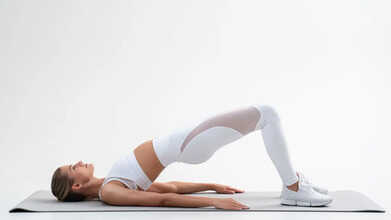- Health Conditions A-Z
- Health & Wellness
- Nutrition
- Fitness
- Health News
- Ayurveda
- Videos
- Medicine A-Z
- Parenting
- Web Stories
Lose Fat Fast with This 6-Day Weight Training And Cardio Routine

Lose Fat Fast with This 6-Day Weight Training And Cardio Routine
If you've completed a bulking phase and are looking to shed excess fat while maintaining muscle mass, this 6-day cutting workout is your perfect guide. Combining weight training with cardio and one day of rest, this program is designed to blast fat and sculpt your physique. However, remember: your diet is just as important as your workout—aim for a daily calorie deficit of about 500 calories for optimal results.
A fat-loss diet focuses on creating a calorie deficit while providing the nutrients your body needs. Prioritize lean proteins like chicken, fish, and tofu to preserve muscle mass and boost metabolism. Include fiber-rich vegetables, fruits, and whole grains for sustained energy and satiety. Healthy fats from sources like avocados, nuts, and olive oil are essential for overall health. Minimize processed foods, sugary drinks, and refined carbs. Hydrate well and plan meals to avoid overeating. Incorporate portion control and mindful eating. Pair your diet with regular exercise for optimal results. Remember, consistency and a balanced approach are key to sustainable fat loss.
Fat Loss Workout
This program includes:
- 3 days of heavy weight training to preserve muscle.
- 3 days of cardio to boost calorie burn.
- 1 rest day for recovery.
- Choose the type of cardio that works best for you—either low-intensity morning sessions or HIIT (High-Intensity Interval Training) in the evening.
6-Day Cutting Routine
Monday: Chest and Triceps
Build upper body strength while burning calories.
- Dumbbell Bench Press: 4 sets of 8, 8, 6, 6 reps
- Incline Bench Press: 4 sets of 8, 8, 6, 6 reps
- Cable Crossovers: 4 sets of 8 reps
- Close Grip Bench Press: 3 sets of 8 reps
- Lying Tricep Extension: 3 sets of 8 reps
- Rope Pulldowns: 3 sets of 8 reps
Tuesday: Abs and Cardio
Focus on core strength and fat burn.
- 20 minutes of core strength exercises.
- Follow with 1 hour of low-intensity cardio or 45 minutes of HIIT.
Wednesday: Back and Biceps
Strengthen your back and arms with slow, controlled movements.
- Wide Grip Pull-Up: 4 sets of 8 reps (use slow negatives or substitute with lat pulldowns).
- Close Grip Pull Down: 4 sets of 8, 8, 6, 6 reps
- Cable Row: 4 sets of 8 reps
- Barbell Curl: 3 sets of 8, 8, 6 reps
- Incline Bench Dumbbell Curl: 3 sets of 8 reps
- Dumbbell Preacher Curl: 3 sets of 8 reps
Thursday: Abs and Cardio
Repeat Tuesday’s routine:
- 20 minutes of core strength exercises.
- Follow with 1 hour of low-intensity cardio or 45 minutes of HIIT
Friday: Legs and Shoulders
Hit your lower body and shoulders for full-body balance.
- Squat: 4 sets of 8 reps
- Stiff Legged Deadlift: 3 sets of 8 reps
- Leg Curl: 3 sets of 8, 8, 6 reps
- Leg Extension: 3 sets of 8, 8, 6 reps
- Standing Calf Raise: 4 sets of 15, 12, 10, 8 reps
- Military Press: 4 sets of 8, 8, 6, 6 reps
- Dumbbell Lateral Raise: 3 sets of 8 reps
- Bent Over Reverse Fly: 3 sets of 8 reps
Saturday: Abs and Cardio
One last cardio and core session to wrap up the week:
- 20 minutes of core strength exercises.
- Follow with 1 hour of low-intensity cardio or 45 minutes of HIIT.
Sunday: Rest Day
Take this day to recover. Focus on hydration, stretching, and maintaining your calorie deficit.
Tips for Fat-Loss Workout
- Exercise alone won't cut it—ensure you’re eating 500 calories below your maintenance level daily.
- Low-intensity cardio is great for beginners, while HIIT is perfect for advanced fat burners.
- You get out what you put in—so challenge your limits with proper form.
- Rest if needed and avoid overtraining.
Pregnant And Doing Yoga? These Are The Yoga Poses To Skip For Safety

Credits: Canva
Yoga is one of the safest and most effective exercises you can do while pregnant, it can help you relax, stay strong, and even get ready for childbirth, according to the Mayo Clinic. However, it is important to take precautions to protect both yourself and your growing baby. While many yoga poses are beneficial during pregnancy, there are some you should avoid. Below, we highlight the yoga poses to steer clear of while expecting.
Is It Safe To Practice Yoga In Pregnancy?
Pregnancy brings a lot of physical changes and discomfort, but that does not mean you have to give up yoga entirely if you already practice it. Many poses are still safe to continue, while others may need to be modified or avoided completely.
Benefits Of Yoga During Pregnancy
Prenatal yoga provides many physical and mental benefits. It improves strength and flexibility, reduces stress and anxiety, eases common pregnancy discomforts like back pain and fatigue, enhances sleep, and prepares both body and mind for labor. Yoga can also help regulate blood pressure, improve circulation, and foster a stronger connection between mother and baby.
Yoga Poses To Avoid During Pregnancy
Here’s a guide to the yoga poses that are best avoided during pregnancy:
Abdominal Work
Any pose that puts pressure on your abdomen can create unnecessary compression and affect blood flow. These poses may also increase strain on your body and contribute to conditions like diastasis recti, where the abdominal muscles separate during pregnancy.
Some poses to avoid include:
- Crow Pose
- Bicycles
- Planks
- Crunches
Twisting & Stretching
Twists are not entirely off-limits during pregnancy. With your doctor’s approval, open twists in the third trimester can feel good and may even help relieve tension. Twisting should come from the shoulders rather than the abdomen, keeping the belly open and never compressed.
Some poses to avoid include:
- Moon Pose
- Spinal Twist
- Boat Pose
- Tree Pose
Jumping or Fast Flowing
Rapid movements or lots of jumping in early pregnancy may cause nausea. Yoga poses that involve quick, high-impact motions should be avoided. Gentle, restorative postures are a safer choice, supporting fetal growth and reducing potential complications.
Poses to avoid:
- Any yoga movement involving rapid or forceful motion
Lying Back
Lying flat on your back during pregnancy can cause nausea, back pain, increased blood pressure, and heartburn. Long periods in this position may also compress the vena cava, the vein that carries blood from the lower body to the heart, which can lead to complications.
Poses to avoid:
- Corpse Pose
- Lying Down Body Twist
- Boat Pose
- Plough Pose
Heated Yoga
Some yoga practices raise your body temperature. During pregnancy, it’s crucial to avoid poses that overheat the body, as this can lead to dehydration and other complications throughout all trimesters.
Poses to avoid:
- Kapalbhati (Breath of Fire Pose)
- Headstand
- Warrior Pose
- Bikram Pose
Belly Down
Poses that put extra pressure on your abdomen can be risky while your baby is growing. Any yoga that requires lying on or bending the stomach should be avoided.
Poses to avoid:
- Swan Pose
- Cobra Pose
- Seated Forward Bend
- Bow Pose
Tyreek Hill Injury: Left Knee Dislocated; Know More About The Common Leg Injuries In Football

Credits: AP
Miami Dolphin's Tyreek Hill's season came to a sudden end on Monday night, when his knee became badly twisted shortly after he made a catch near the sideline. The coach Mike McDaniel confirmed that Hill was diagnosed with a dislocated knee and had to be in hospital overnight.
An air cast was also placed over his leg, which was taken off the field on cart. He was then taken to a nearby hospital, and kept for "imaging, evaluation, and observation".
McDaniel said, "He immediately had wide eyes and was talking, 'I'm good, just make sure the guys get this win.' He was focused on the team."
As of now, Hill will be undergoing an MRI exam and a CT scan. His agent Drew Rosenhaus told WSVN that he is being checked for any torn ligaments, cartilage, broken bones or nerve damage.
Associated Press has reported that Hill ha been taken off field for left knee dislocation.
What Happens In A Knee Dislocation?
As per the National Institute of Health, US, a knee dislocation is a potentially devastating injury and is often a surgical emergency. Knee dislocations comprise ligamentous, bony, and neurovascular injuries that, when unrecognized, significantly increase the risk of amputation of the affected limb. Even dislocations that spontaneously reduce before evaluation by a healthcare professional carry the risk of significant neurovascular injury.
Delayed diagnosis and management of knee dislocations increases the risk of long-term arthrofibrosis and joint instability. While most dislocated knees never fully return to their pre-injury state, timely and accurate diagnosis paired with prompt intervention can significantly improve outcomes for patients with this potentially complex orthopedic injury.
Common Leg Injuries In Football
As per the Southern Pain and Neurological Clinic, football is one of the most dangerous contact sports in the United States, this is also a reason why players wear layers of protective clothing and equipment.
According to the National Library of Medicine, the most common injury types in football include strains at 40%, contusions at 25%, dislocations at 15%, fractures at 10%, and concussions at 5%.
Read: 21-year-old Billy Vigar Of Chichester City Dies Of Sustaining Brain Injury
Common Injuries Include:
Muscle Strains
This happens when a muscle or tendon is overstretched, mainly due to acceleration or deceleration. This injury is also known as pulled muscles and typically affects the lower back, hamstrings, or ankles.
Knee Ligament Injury
Ligaments connect bones in the body, and ligaments that connect the lower leg to the thigh bone are most susceptible to injuries in football.
There are four knee ligaments injuries that can happen:
- ACL or the Anterior cruciate ligament at the center of the knee
- PCL or the Posterior cruciate ligament at the center of the knee
- MCL or the Medial collateral ligament on the inside of the knee
- LCL or the Lateral collateral ligament on the outside of the knee
Among these, the most common knee ligament injury in football is the rapture of the ACL. This is because it is the ligament that controls the rotation of the shinbone and forward movement.
Achilles Tendonitis
This happens when the tendon linking the calf muscles to the heel becomes irritated or injured. This often results from intense or repetitive strain. The condition can cause sharp pain and, in severe cases, make it difficult or even impossible to walk, jump, or move the toes.
Hamstring Strains
This happens when a player over stretches while running, jumping, or in action. This happens with a sharp pain at the back of the thigh and in severe cases, a player may have a torn hamstring.
5 Pelvic Floor Exercises That Can Transform Your Sexual Wellness

Credits: Canva
Your pelvic floor muscles do much more for your sexual health than most people realise. These deep muscles support the bladder, uterus, and bowel, but they also play a big part in pleasure, performance, and confidence during intimacy.
Whether you’re healing after childbirth, managing incontinence, or simply aiming to feel more connected with your body, training your pelvic floor is a natural way to improve sexual wellness.
What Is Pelvic Floor Exercise?
Pelvic floor exercises, often called Kegels, focus on strengthening the group of muscles that create a supportive sling for the bladder, bowel, and, in women, the uterus. They are done by contracting these muscles, as if stopping the passage of urine or gas, holding the squeeze, and then releasing. Regular practice can improve bladder and bowel control, enhance sexual health, and aid recovery following childbirth in women or prostate surgery in men.ALSO READ: Is It Safe To Have Sex With Heart Disease? Expert Tells 5 Things You Should Keep In Mind
Benefits of Pelvic Floor Exercise For Better Sexual Health
Pelvic floor exercises can make a real difference in your sexual life. As per Mayo Clinic, by strengthening the muscles that support the bladder, uterus, and bowel, these exercises improve blood flow and muscle control in the pelvic area. This not only enhances arousal and sensitivity but can also lead to stronger orgasms and better stamina during intimacy. For many people, a stronger pelvic floor helps reduce discomfort, boost confidence, and create a greater sense of connection with their body and partner.ALSO READ: Can A UTI Cause You Your Limbs? Explains Doctor
5 Pelvic Floor Exercises to Boost Sexual Health
1. Kegel Exercises
How to do it:- Squeeze the muscles you use to stop urinating.
- Hold for 5 seconds, then relax for 5 seconds.
- Repeat 10–15 times, two to three times daily.
2. Bridge Pose
How to do it:- Lie on your back with your knees bent and feet flat.
- Lift your hips upward while tightening your glutes and pelvic muscles.
- Hold briefly, then lower down.
3. Deep SquatsHow to do it:
- Stand with your feet hip-width apart.
- Lower into a deep squat, keeping your chest lifted.
- Engage your pelvic muscles as you come back up.
4. Bird-Dog
How to do it:- Begin on your hands and knees.
- Extend your right arm and left leg at the same time.
- Hold, then switch sides.
5. Pelvic Tilts
How to do it:- Lie on your back with your knees bent.
- Flatten your lower back into the floor by tilting your pelvis upward.
- Hold for a few seconds, then relax.
© 2024 Bennett, Coleman & Company Limited

